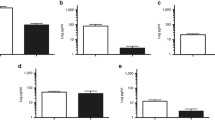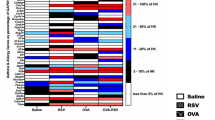Abstract
Background
Chlamydia pneumoniae causes respiratory infection in adults and children, and has been associated with asthma exacerbations and induction of Immunoglobulin (Ig) E responses. We previously reported that C. pneumoniae enhances T helper (Th) 2 responses of peripheral blood mononuclear cells (PBMC) from asthmatic patients. It is likely that toll like receptor (TLR)-2 and TLR-4 mediate cytokine responses and host defense against C. pneumoniae. Thus, we sought to determine whether engagement of TLR-2 or TLR-4 may induce IL-12 production in our C. pneumoniae model.
Methods
PBMC (1.5 × 106) from asthmatic patients (N = 10) and non-asthmatic controls (N = 5) were infected or mock-infected for 1 h ± C. pneumoniae TW183 at a multiplicity of infection (MOI) = 1 and MOI = 0.1, and cultured for 48 h ± anti- TLR-2 and TLR-4 antibodies (Abs) (1 mg/mL). Interleukin (IL)-12 (48 h p.i.) and total IgE levels (day 10) were measured in supernatants (ELISA).
Results
High IgE levels were detected in supernatants of C. pneumoniae- infected PBMC from asthmatics on day 10, compared with mock-infected PBMC (p < 0.03). In contrast, IgE was not detected (<0.3 ng/mL) in either C. pneumoniae infected or mock-infected PBMC from non-asthmatics. IL-12 production by C. pneumoniae-infected asthmatic and non-asthmatic PBMC were similar. When anti-TLR4, but not anti-TLR2, was included in culture, IL-12 production by C. pneumoniae- infected asthmatic PBMC decreased.
Conclusions
C. pneumoniae infection induces IgE production and modulates IL-12 responses in patients with asthma, which may be caused, in part, by differences in TLR-2 and TLR-4 stimulation.



Similar content being viewed by others
Abbreviations
- C. pneumoniae :
-
Chlamydia pneumoniae
- Ab:
-
Antibodies
- IFN-γ:
-
Interferon γ
- IL:
-
Interleukin
- Ig:
-
Immunoglobulin
- MIF:
-
Microimmunofluorescence
- PBMC:
-
Peripheral blood mononuclear cells
- Th:
-
T helper
- TLR:
-
Toll like receptor
- TNF-α:
-
Tumor necrosis factor alpha
- ELISA:
-
Enzyme-linked immunosorbent assay
- PAMPs:
-
Pathogen-associated molecular patterns
References
Emre U, Roblin PM, Gelling M et al (1994) The association of Chlamydia pneumoniae infection and reactive airway disease in children. Arch Pediatr Adolesc Med 148:727–731
Biscione GL, Corner J, Chauhan AJ et al (2004) Increased frequency of detection of Chlamydophila pneumoniae in asthma. Eur Resp J 24:745–749
Airenne S, Surcel HM, Alakarppa H et al (1999) Chlamydia pneumoniae infection in human monocytes. Infect Immun 67:1445–1449
Halme S, Latvala J, Karttunen R et al (2000) Cell-mediated immune response during primary Chlamydia pneumoniae infection. Infect Immun 68:7156–7158
Redecke V, Dalhoff K, Bohnet S, Braun J, Maass M (1998) Interaction of Chlamydia pneumoniae and human alveolar macrophages: infection and inflammatory response. Am J Respir Cell Mol Biol 19:721–727
Stahl PD, Ezekowitz RA (1998) The mannose receptor is a pattern recognition receptor involved in host defense. Curr Opin Immunol 10:50–55 (review)
Takeuchi O, Hoshino K, Kawai T et al (1999) Differential roles of TLR2 and TLR4 in recognition of gram-negative and gram-positive bacterial cell wall components. Immunity 11:443–451
Akira S, Takeda K, Kaisho T (2001) Toll-like receptors: critical proteins linking innate and acquired immunity. Nat Immunol 2:675–680
Halme S, Latvala J, Karttunen R et al (2000) Cell-mediated immune response during primary Chlamydia pneumoniae infection. Infect Immun 68:7156–7158
Trinchieri G (1995) Interleukin-12: a proinflammatory cytokine with immunoregulatory functions that bridge innate resistance and antigen-specific adaptive immunity. Annu Rev Immunol 13:251–276
Smith-Norowitz TA, Chotikanatis K, Erstein DP et al (2016) Chlamydia pneumoniae enhances the Th2 profile of stimulated peripheral blood mononuclear cells from asthmatic patients. Hum Immunol 77:382–388
Willis-Karp M (2001) IL-12/IL-13 in allergic asthma. J Allergy Clin Immunol 107:9–18
Cowen MK, Wakefield DB, Cloutier MM (2007) Classifying asthma severity: objective versus subjective measures. J Asthma 44:711–715
EPR-3 (2007) Expert panel report 3: guidelines for the diagnosis and management of asthma (EPR-3 2007). US Department of Health and Human Services; National Institutes of Health; National Heart, Lung, and Blood Institute; National Asthma Education and Prevention Program :40–43. http://www.nhlbi.nih.gov/guidelines/asthma/asthgdln.pdf
Wang SP, Grayston JT (1986) Microimmunofluorescence serological studies with the TWAR organism. In: Oriel D, Ridgeway G (eds) Chlamydial infections: proceedings of the sixth international symposium on human chlamydial infections. Cambridge University Press, Cambridge, pp 329–332
Roblin PM, Dumornay W, Hammerschlag MR (1992) Use of HEp-2 cells for improved isolation and passage of Chlamydia pneumoniae. J Clin Microbiol 1992(30):1968–1971
Apfalter P, Barousch W, Nehr M et al (2003) Comparison of a new quantitative ompA-based real-time PCR TaqMan assay for detection of Chlamydia pneumoniae DNA in respiratory specimens with four conventional PCR assays. J Clin Microbiol 41:592–600
Dzhindzhikhashvili MS, Joks R, Smith-Norowitz TA et al (2013) Doxycycline suppresses Chlamydia pneumoniae-mediated increases in ongoing immunoglobulin E and interleukin-4 responses by peripheral blood mononuclear cells of patients with allergic asthma. J Antimicrob Chemother 68:2363–2368
Wissel H, Schulz C, Koehne P et al (2005) Chlamydophila pneumoniae induces expression of Toll-like Receptor 4 and release of TNF-α and MIP-2 via an NF-κβ pathway in rat type II pneumocytes. Respir Res 6:51
Heinemann M, Susa M, Simnacher U, Marre R, Essig A (1996) Growth of Chlamydia pneumoniae induces cytokine production and expression of CD14 in a human monocytic cell line. Infect Immun 64:4872–4875
Kaukoranta-Tolvanen SS, Ronni T, Leinonen M, Saikku P, Laitinen K (1996) Expression of adhesion molecules on endothelial cells stimulated by Chlamydia pneumoniae. Microb Pathog 21:407–411
Pentilla JM, Anttila M, Puolakkainen M et al (1998) Local immune responses to Chlamydia pneumoniae in the lungs of BALB/c mice during primary infection and reinfection. Infect Immun 66:5113–5118
Geng Y, Berencsi K, Gyulai Z et al (2000) Roles of interleukin-12 and gamma interferon in murine Chlamydia pneumoniae infection. Infect Immun 68:2245–2253
Orgun NN, Mathis MA, Wilson CB, Way SS (2008) Deviation from a strong Th1-dominated to a modest Th17-dominated CD4 T cell response in the absence of IL-12p40 and type I IFNs sustains protective CD8 T cells. J Immunol 180:4109–4115
Prebeck S, Kirschning C, Durr S et al (2001) Predominant role of toll-like receptor 2 versus 4 in Chlamydia pneumoniae-induced activation of dendritic cells. J Immunol 167:3316–3323
Bulut Y, Faure E, Thomas L et al (2002) Chlamydial heat shock protein 60 activates macrophages and endothelial cells through Toll-like receptor 4 and MD2 in a MyD88-dependent pathway. J Immunol 168:1435–1440
Costa CP, Kirschning CJ, Busch D et al (2002) Role of chlamydial heat shock protein 60 in the stimulation of innate immune cells by Chlamydia pneumoniae. Eur J Immunol 32:2460–2470
Acknowledgements
We would like to thank Kevin B. Norowitz, M.D., Department of Pediatrics, SUNY Downstate Medical Center for fruitful discussions.
Author information
Authors and Affiliations
Corresponding author
Ethics declarations
Conflict of interest
The authors declare no conflict of interest to disclose.
Human and animal rights statement
Research involving human participants was approved by the SUNY Downstate Med Ctr IRB committee (stated in methods).
Informed consent
We had informed consent from patients.
Funding
This work was supported by the Thrasher Research Fund (Young Investigator Award awarded to Stephan Kohlhoff, M.D.) and a NY State Divisional Grant (Awarded to Tamar A. Smith-Norowitz, Ph.D).
Rights and permissions
About this article
Cite this article
Smith-Norowitz, T.A., Perlman, J., Norowitz, Y.M. et al. Chlamydia pneumoniae induces interleukin-12 responses in peripheral blood mononuclear cells in asthma and the role of toll like receptor 2 versus 4: a pilot study. Ir J Med Sci 186, 511–517 (2017). https://doi.org/10.1007/s11845-016-1549-9
Received:
Accepted:
Published:
Issue Date:
DOI: https://doi.org/10.1007/s11845-016-1549-9




